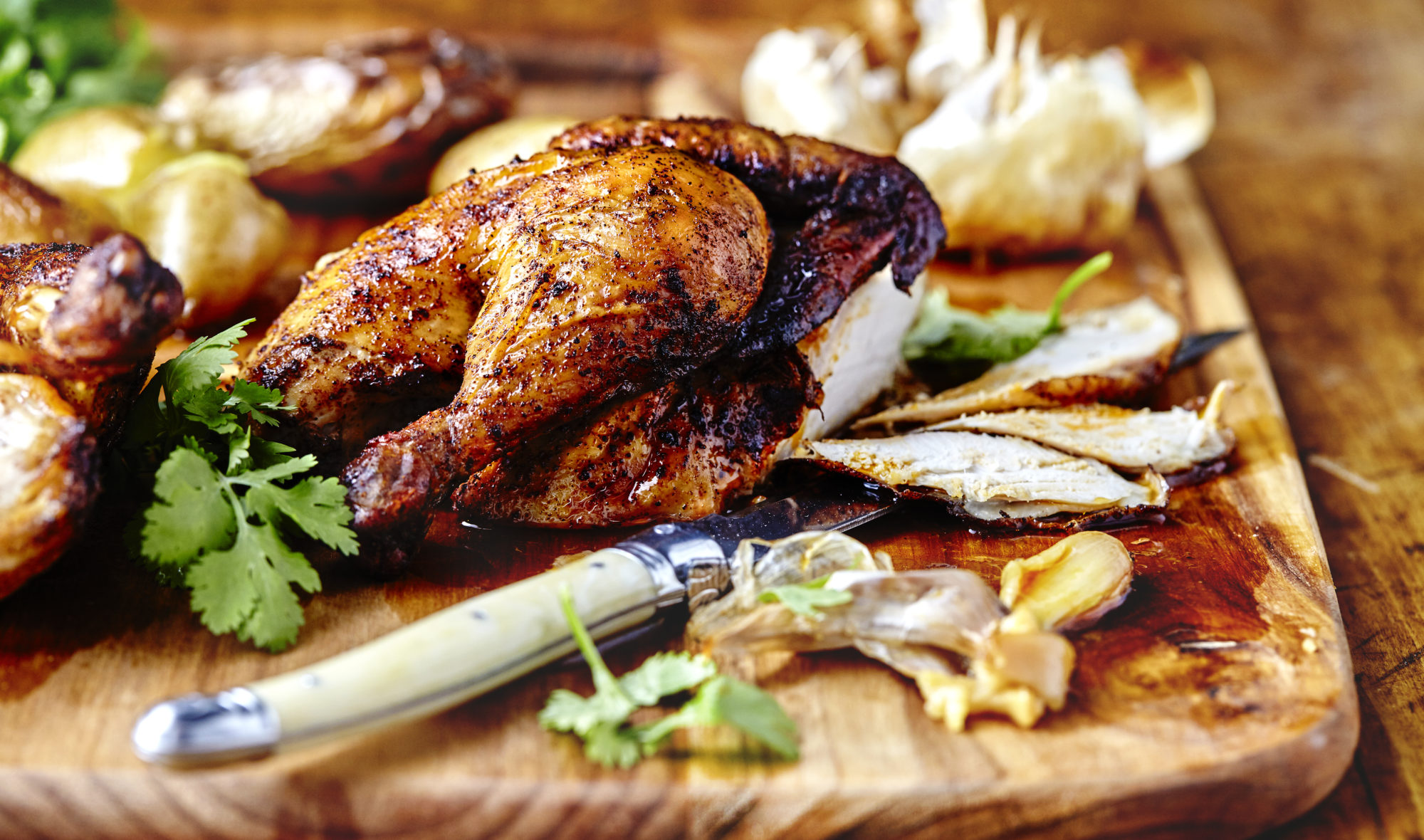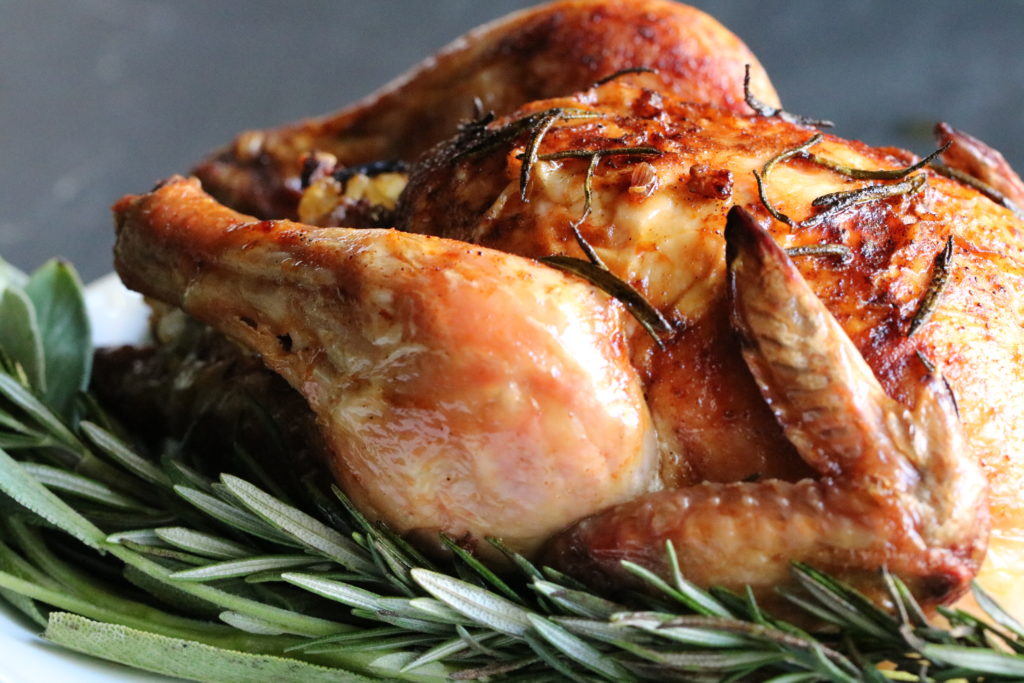
Join PN Level 2 for less than $9 USD/day! Affordable monthly payments now open.

In practical terms, a Cornish hen is basically a small chicken that serves one. Specifically, Cornish hens are about half the size of an average chicken. Although they are called “hens” and sometimes also referred to as Cornish game hens, Cornish hens are neither necessarily female (they can be male too), nor are they game birds. Cornish hens are fancier, more delicately flavored, and more tender than chicken. Cornish hens are often served whole due to their small size and are rich in protein.
The USDA defines the Cornish hen as “a young immature chicken (less than five weeks of age), weighing not more than two pounds ready-to-cook weight, which was prepared from a Cornish chicken or the progeny of a Cornish chicken crossed with another breed of chicken.”
In more practical terms, a Cornish hen is a chicken that is small enough to be eaten in one sitting, by one person.
Compared to regular chickens, Cornish hens weigh less (typically no more that two pounds compared to the three to five pounds a regular chicken weighs) and reach maturity faster (28 days as opposed to 50 days).
While regular chicken is very common to the average North American’s dinner plate, Cornish hen is typically reserved for special occasions. In keeping with its lavish reputation, Cornish hen is slightly harder to find in grocery stores and consumers can expect to pay a higher price per pound compared to regular chicken.
Cornish hens look like petite chickens. Whole, they can easily fit in the palm of your hand.
Although they still have all of the same cuts as a regular chicken (breast, drumstick, wing, etc.), Cornish hens are usually served whole rather than in parts because they are so small.
The tender meat of the Cornish hen has a subtle, more delicate flavor than that of a regular chicken, although the taste is still distinctly “chicken-y”.
Like a regular chicken, Cornish hens are pink when they are raw, and golden brown and crispy on the outside when roasted.
One whole roasted Cornish hen, meat and skin included (about 257g), has 666 calories, 57.2g protein, 46.8g fat, and no carbohydrates, fiber, or sugar. Cornish hens are not a significant source of any vitamins or minerals.
Cornish hens are typically only found at specialty butcher shops or very large grocery stores.
A general rule for buying meats is to shop at stores you trust, where you can ask questions about the source, quality, and farming practices of the meat you’re purchasing. Local butchers, farmers’ markets, and grocery stores with well-trained staff are excellent places to start these relationships.
Raw Cornish hens should have a pale rosy color and have little to no odor. Don’t purchase if the meat shows signs of greying or is emitting a foul odor.
Always check the expiration date on the package to ensure freshness.
A raw Cornish hen in a well-sealed package can be stored in the fridge for up to two days before cooking, or it can be frozen for up to six months. If you are planning to freeze it for longer than two months, over-wrap the original packaging with extra plastic wrap or tinfoil to prevent freezer burn.
A cooked Cornish hen that is wrapped tightly in plastic wrap or tinfoil will stay fresh in the fridge for about three to four days, or it can be frozen for up to six months.
If stuffed, remove the stuffing and store in a separate container before refrigerating or freezing the bird.
For safest results, thaw frozen Cornish hen in the fridge, rather than on the counter at room temperature.
Raw chicken can harbor salmonella bacteria, so when preparing Cornish hen, it’s important to work in a clean, organized manner. Wash everything that touches the raw meat well with hot water and soap.
Most commonly, Cornish hens are cooked whole in the oven.
Here’s how to do that:
Preheat the oven to 375 degrees Fahrenheit. Place the Cornish hen(s) on a lined baking sheet, leaving space between the birds if you are cooking multiples. Drizzle the back of the bird with olive oil (about 1 tsp to 1 tbsp of oil for each), sprinkle with salt, pepper, and your choice of seasoning. Using clean hands, rub this oil and seasoning mixture into the skin, coating the entire surface of the bird. Place a lemon wedge, a few cloves of garlic, and a sprig of herbs into each cavity. Place the baking tray in the oven and roast for about 50-60 minutes, or until the thickest cut of meat is cooked through and the juices run clear. Then, remove the hens from the oven, let them rest for 10 minutes, and serve.

Using fresh herbs like rosemary, sage, thyme, and marjoram intensifies the flavors of this dish. Please your taste buds and your guests with this delicious dish!
Prep Time: 10 minutes Cook Time: 90 minutes Yield: 4 servings
For the Stuffing:
Begin by cooking the wild rice according to the directions on the box or bag of rice.
While your rice is cooking, add the olive oil to a skillet and sauté the celery, carrots, mushrooms, and onion. Mix in herbs, sea salt, and pepper.
Once your rice is cooked and veggies / herbs sautéed, mix them together in a bowl.
For the Hen:
Preheat oven to 450 degrees Fahrenheit.
Stuff each Cornish hen with the prepared stuffing.
Note that there may be some extra stuffing, which can be served as a side. However, if you plan on serving leftovers as a side, make sure that the leftover stuffing did NOT come in contact with the raw hen (e.g. use a fresh spoon to stuff each hen so that the spoon that touches the raw hen isn’t dipped back into the bowl full of stuffing).
Rub each Cornish hen with 1 tsp of butter or coconut oil. Sprinkle the hens with 1 tbsp of fresh rosemary and ½ tsp paprika each.
Place the hens on a baking tray lined with tin foil, spaced apart from one another.
Bake in preheated 450 degree Fahrenheit oven for 20 minutes. Once 20 minutes is up, reduce the oven temperature to 400 degrees Fahrenheit and continue to bake for another 40 – 50 minutes (until skin is crispy and light brown and the meat, when cut into, is no longer pink). Note that depending on your oven, the cook time could be more.
If there is leftover stuffing, serve as an additional side.
Enjoy!
Precision Nutrition’s Encyclopedia of Food expands every single month as we highlight new foods and showcase beautiful food photography. If you’d like to stay up to date, simply click this link. From there, we’ll send you a FREE copy of our recipe book. We’ll also let you know when new and delicious foods are added to the site.
In practical terms, a Cornish hen is basically a small chicken that serves one. Specifically, Cornish hens are about half the size of an average chicken. Although they are called “hens” and sometimes also referred to as Cornish game hens, Cornish hens are neither necessarily female (they can be male too), nor are they game birds. Cornish hens are fancier, more delicately flavored, and more tender than chicken. Cornish hens are often served whole due to their small size and are rich in protein.